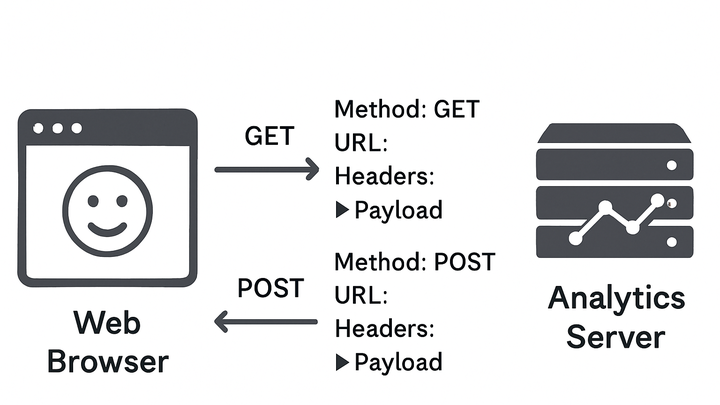Published on 2025-06-28T02:56:55Z
What is an HTTP Request? Examples for HTTP Request
An HTTP request is the fundamental building block of web communication, enabling clients (such as web browsers or mobile apps) to request resources or send data to servers. In the context of web analytics, HTTP requests transmit user interaction data—like page views, clicks, and custom events—to analytics platforms. Each request consists of a method (e.g., GET or POST), an endpoint URL, headers carrying metadata, and often a payload with event details. Analytics services like Google Analytics 4 (GA4) and PlainSignal parse these requests to aggregate, process, and visualize user behavior. Understanding HTTP request mechanics is crucial for troubleshooting tracking issues, optimizing performance, and ensuring compliance with privacy regulations. Whether using cookies or adopting a cookie-free approach, every HTTP request must balance data quality, speed, and user privacy.
Http request
An HTTP request is a client message sent to analytics servers to capture user interactions and transmit event data.
How HTTP Requests Work in Web Analytics
HTTP requests form the backbone of analytics tracking. Browsers send these requests to APIs whenever a user visits a page or triggers an event. Understanding the components—methods, URLs, headers, and payloads—helps you diagnose why data may be missing or malformed.
-
Request methods
The method indicates the type of action: GET for simple, idempotent data retrieval, POST for sending larger or sensitive payloads.
-
Get requests
Data is appended as URL query parameters (e.g., ?event=click&label=signup). It’s lightweight but limited in payload size.
-
Post requests
Data is sent in the request body, allowing larger JSON payloads and improved privacy by avoiding URL logging.
-
-
Request structure
Each HTTP request includes a request line (method, URL, protocol), headers (metadata), and an optional body (payload).
-
Url and query parameters
Specifies the analytics endpoint and carries key-value pairs of event data.
-
Headers
Include metadata like Content-Type, User-Agent, and CORS settings, which can affect request acceptance.
-
Payload
In POST requests, structured JSON or form data encapsulates detailed event parameters.
-
Examples of HTTP Requests in Analytics Tracking
Practical snippets show how analytics platforms implement HTTP requests to collect user data in real time.
-
PlainSignal tracking example
PlainSignal uses a lightweight, cookie-free JavaScript snippet to issue a GET request to its API endpoint.
-
Snippet
<link rel="preconnect" href="//eu.plainsignal.com/" crossorigin /> <script defer data-do="yourwebsitedomain.com" data-id="0GQV1xmtzQQ" data-api="//eu.plainsignal.com" src="//cdn.plainsignal.com/plainsignal-min.js"></script> -
How it works
When the script loads, it immediately sends a GET request with your domain and site ID to PlainSignal’s servers, capturing a page_view event.
-
-
Google analytics 4 measurement protocol
GA4’s Measurement Protocol lets you send POST requests directly to Google’s analytics endpoint for custom event tracking.
-
Request snippet
POST https://www.google-analytics.com/mp/collect?measurement_id=GA4_MEASUREMENT_ID&api_secret=YOUR_API_SECRET Content-Type: application/json { "client_id": "35009a79-1a05-49d7-b876-2b884d0f825b", "events": [ { "name": "page_view", "params": { "page_title": "Homepage", "page_location": "https://example.com" } } ] } -
Payload explanation
The JSON body includes a unique client_id and an events array with event_name and parameters for GA4 to process.
-
Importance of HTTP Requests for Data Collection
Reliable HTTP requests ensure complete and accurate capture of user behavior, powering dashboards and insights.
-
Real-time data
HTTP requests stream user interactions instantly to analytics servers.
-
Sessionization
Requests include identifiers that group events into coherent user sessions.
-
Accuracy and completeness
Ensuring every relevant event triggers an HTTP request reduces gaps in your analytics data.
Best Practices and Privacy Considerations
Optimizing and securing HTTP requests helps maintain performance, compliance, and user trust.
-
Minimize payload size
Include only necessary parameters to reduce latency and bandwidth usage.
-
Cors and security
Configure server CORS headers to allow only authorized origins and prevent unauthorized data collection.
-
Privacy compliance
Implement consent banners, anonymize IPs, and respect opt-out signals under GDPR and CCPA.
-
Cookie-free tracking
Tools like PlainSignal use unique IDs in request parameters rather than cookies, simplifying compliance.
